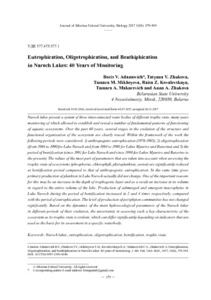Эвтрофирование, олиготрофикация и бентификация в Нарочанских озерах: 40 лет мониторинговых исследований
Скачать файл:
URI (для ссылок/цитирований):
https://elib.sfu-kras.ru/handle/2311/69465Автор:
Адамович, Б.В.
Жукова, Т.В.
Михеева, Т.М.
Ковалевская, Р.З.
Макаревич, Т.А.
Жукова, А.А.
Adamovich, Boris V.
Zhukova, Tatyana V.
Mikheyeva, Tamara M.
Kovalevskaya, Raisa Z.
Makarevich, Tamara A.
Zhukova, Anna A.
Дата:
2017-12Журнал:
Журнал Сибирского федерального университета. Биология. Journal of Siberian Federal University. Biology; 2017 10 (4)Аннотация:
Нарочанские озера представляют собой систему из трех связанных между собой водоемов
разной трофности, многолетний мониторинг которых позволил установить и раскрыть ряд
фундаментальных закономерностей функционирования водных экосистем. За последние 60
лет хорошо просматривается несколько этапов в эволюции структурной и функциональной
организации экосистемы. В рамках работы рассмотрены периоды: 1) антропогенного
эвтрофирования (1978-1983 гг.); 2) олиготрофикации (с 1984 по 1990 г. для оз. Нарочь, и с 1984
по 1989 г. для озер Мястро и Баторино) и 3) период бентификации (с 1991 г. для оз. Нарочь и с
1990 г. для оз. Мястро и Баторино по настоящее время). Практически все параметры, которые
принято считать показательными при оценке трофности экосистемы (фосфор, хлорофилл,
фитопланктон, сестон), существенно снизились в период бентификации по отношению к
периоду антропогенного эвтрофирования. При этом валовая первичная продукция планктона
в оз. Нарочь фактически не изменилась. Одной из важных причин этого может быть
возрастание трофогенного слоя и, соответственно, увеличение соотношения его объема ко
всему объему озера. Продукция погруженных и воздушно-водных макрофитов в оз. Нарочь
в период бентификации увеличилась в 2 и 4 раза соответственно в сравнении с периодом
эвтрофирования. Уровень продукции перифитонных сообществ существенно не изменился.
На примере динамики основных гидроэкологических показателей Нарочанских озер в разные
периоды их эволюции очевидна неоднозначность в оценке такой ключевой характеристики
экосистемы, как ее трофический статус, который может существенно отличаться в
зависимости от того, какие показатели положены в основу его оценки в конкретном водном
объекте Naroch lakes present a system of three interconnected water bodies of different trophic state, many years
monitoring of which allowed to establish and reveal a number of fundamental patterns of functioning
of aquatic ecosystems. Over the past 60 years, several stages in the evolution of the structure and
functional organization of the ecosystem are clearly traced. Within the framework of the work the
following periods were considered: 1) anthropogenic eutrophication (1978-1983); 2) oligotrophication
(from 1984 to 1990 for Lake Naroch and from 1984 to 1990 for Lakes Myastro and Batorino) and 3) the
period of bentification (since 1991 for Lake Naroch and since 1990 for Lakes Myastro and Batorino to
the present). The values of the most part of parameters that are taken into account when assessing the
trophic state of ecosystems (phosphorus, chlorophyll, phytoplankton, seston) are significantly reduced
at bentification period compared to that of anthropogenic eutrophication. In the same time gross
primary production of plankton in Lake Naroch actually did not change. One of the important reasons
for this may be an increase in the depth of trophogenic layer and as a result an increase in its volume
in regard to the entire volume of the lake. Production of submerged and emergent macrophytes in
Lake Naroch during the period of bentification increased in 2 and 4 times respectively, compared
with the period of eutrophication. The level of production of periphyton communities has not changed
significantly. Based on the dynamics of the main hydroecological parameters of the Naroch lakes
in different periods of their evolution, the uncertainty in assessing such a key characteristic of the
ecosystem as its trophic state is evident, which can differ significantly depending on indicators that are
used as the basis for its assessment in a specific waterbody

